Hops in Beer Brewing: California Cluster
Published: August 14, 2025 at 6:47:23 AM UTC
California Cluster Hops are a true dual-use hop, providing a generic but pleasant bitterness and flavor. This makes them a versatile choice for beer brewing. With a rich history and distinct characteristics, California Cluster Hops have been a staple in the brewing industry. Their unique growing conditions and brewing properties make them an ideal choice for various beer styles.
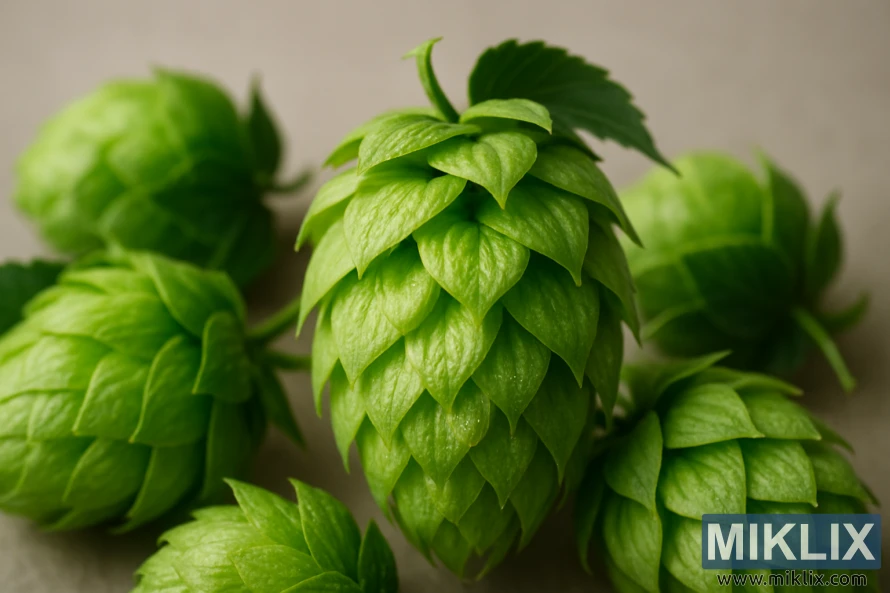
Key Takeaways
- California Cluster Hops offer a balanced bitterness and flavor profile.
- They are suitable for a variety of beer styles.
- Their brewing properties make them a popular choice among brewers.
- Understanding the characteristics of California Cluster Hops is essential for optimal brewing.
- California Cluster Hops are a versatile hop variety for beer brewing.
The History of California Cluster Hops
The origins of California Cluster Hops remain a mystery, yet their influence on brewing is clear. These hops have a storied past, tracing back to the early 20th century. They were favored by US brewers for their unique bitterness and flavor.
Their exact lineage is unclear, but they are known to be the parent of Calicross. They were successfully bred to create disease-resistant strains. This trait made them highly sought after in brewing, boosting crop yields and reducing disease-related losses.
For decades, California Cluster Hops were a cornerstone in US brewing. They significantly influenced American beer styles. Their use cemented the US as a key player in the global beer market.
- California Cluster Hops were known for their bitterness and flavor.
- They were used to produce disease-resistant strains.
- Their use helped establish the US as a major player in the global beer market.
The history of California Cluster Hops highlights the critical role of hop breeding in brewing. By delving into their origins and characteristics, brewers gain a deeper appreciation for their contribution to quality beers.
Understanding California Cluster Hops Characteristics
Grasping the traits of California Cluster Hops is key to their brewing significance. These hops stand out due to their unique chemical makeup. This makeup greatly shapes the beer's bitterness and taste.
California Cluster Hops are recognized for their alpha acid content, spanning from 5.5% to 8.5%. Alpha acids are essential for beer bitterness. A higher alpha acid percentage means a more bitter beer.
Beyond alpha acids, these hops also boast beta acids, ranging from 4.5% to 5.5%. Beta acids influence beer bitterness and flavor stability. They are more enduring than alpha acids, adding to the beer's character over time.
The co-humulone composition is another critical aspect of California Cluster Hops. Co-humulone, a part of alpha acids, impacts bitterness quality. Hops with higher co-humulone levels create a harsher bitterness. Those with lower levels offer a smoother bitterness.
These characteristics make California Cluster Hops a valuable tool in brewing. By comprehending their hop traits, brewers can fine-tune their beers. They can achieve the perfect balance of flavor and bitterness.
Essential Growing Conditions for Cluster Hops
Cluster Hops are a key ingredient in many beers, needing specific climate, soil, and water conditions to flourish. To cultivate top-notch Cluster Hops, brewers must grasp the critical growing conditions for this hop variety.
The climate is fundamental for hop cultivation. Cluster Hops excel in temperate climates with moderate temperatures and sufficient moisture. Areas with warm summers and cool winters are perfect, facilitating a gradual maturation process.
Soil quality is also essential for Cluster Hops' growth. They thrive in well-drained soil, rich in nutrients. The optimal soil pH for Cluster Hops is between 6.0 and 7.0, slightly acidic to neutral.
Water is another critical element in cultivating Cluster Hops. They need consistent moisture, more so in their early growth stages and during dry spells. Yet, excessive water can harm, causing root rot and other problems.
To enhance Cluster Hops' growth, farmers should also consider sunlight exposure and soil aeration. Achieving a balance in hop cultivation, considering climate, soil, and water, is key to producing superior Cluster Hops.
- Climate: Temperate with moderate temperatures
- Soil: Well-drained, nutrient-rich, pH 6.0-7.0
- Water: Adequate moisture, avoiding overwatering
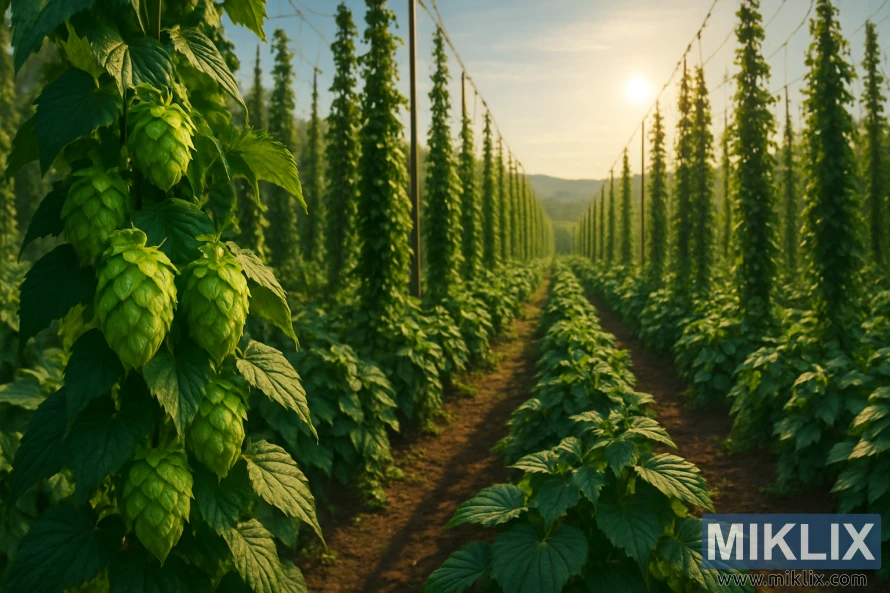
Chemical Composition and Brewing Properties
California Cluster Hops are prized for their balanced chemical makeup. This equilibrium is mainly due to their moderate alpha acid content. This content adds to their bitterness and flavor profile.
The alpha acids in hops are key to beer's bitterness. The essential oils, on the other hand, shape the flavor and aroma. California Cluster Hops' brewing properties make them versatile for various beer styles.
These hops offer a balanced bitterness and flavor, perfect for complex beers. Their alpha acid content, usually between 6-9%, ensures a smooth bitterness. This complements both classic and contemporary beer styles.
To grasp California Cluster Hops' brewing properties, let's look at their use in different beers. They're highly sought after in:
- American-style ales for their balanced flavor
- Lagers where a clean bitterness is desired
- Pale ales and IPAs for their hoppy flavors
Understanding California Cluster Hops' chemical makeup and brewing properties helps brewers. They can better use these hops to achieve their desired beer characteristics.
Harvesting and Processing Methods
Cluster Hops are harvested in late summer to early fall, depending on the variety and growing conditions. The process involves cutting the hop cones from the plant, usually by machine. This method minimizes damage and preserves the delicate lupulin glands.
After harvesting, hops undergo processing to remove excess moisture and preserve their flavor and aroma. This includes drying, packaging, and storage steps.
Drying is a critical step in hop processing. It prevents spoilage and preserves the hops' natural oils. Hops are dried using hot air or mechanical dryers to reduce moisture to around 8-10%.
Here are some key considerations for drying and processing Cluster Hops:
- Temperature control: Drying temperature should be between 140°F to 160°F to preserve the delicate alpha acids and oils.
- Moisture content: Hops should be dried to a moisture content of 8-10% to prevent mold and spoilage.
- Packaging: Dried hops are typically packaged in airtight bags or containers to preserve freshness and prevent exposure to oxygen.
Proper storage is also critical to maintain hop quality. Hops should be stored in a cool, dry place, away from direct sunlight and heat sources.
Some hop farms, like Hops-Meister in Clearlake, California, have reintroduced traditional varieties of Cluster Hops. They emphasize the importance of preserving heritage hop varieties.
Aroma and Flavor Profile Analysis
For brewers aiming to craft specific beer styles, grasping the aroma and flavor profile of California Cluster Hops is key. These hops stand out with their distinct traits, shaping the beer's overall taste and smell.
California Cluster Hops are celebrated for their citrusy notes and complex flavors. They offer a mix of citrus, floral, and herbal tastes. This rich profile makes them ideal for a wide range of brewing projects.
- Citrus notes provide a bright, refreshing quality.
- Floral hints add a subtle, elegant dimension.
- Herbal flavors contribute depth and complexity.
The blend of these characteristics positions California Cluster Hops as a prized ingredient in brewing. By mastering their aroma and flavor, brewers can create beers that align with traditional styles or push the boundaries of innovation.
In summary, the unique aroma and flavor profile of California Cluster Hops open up a world of possibilities for brewers. They can enhance classic beer styles or pioneer new ones, making each brew a unique experience.
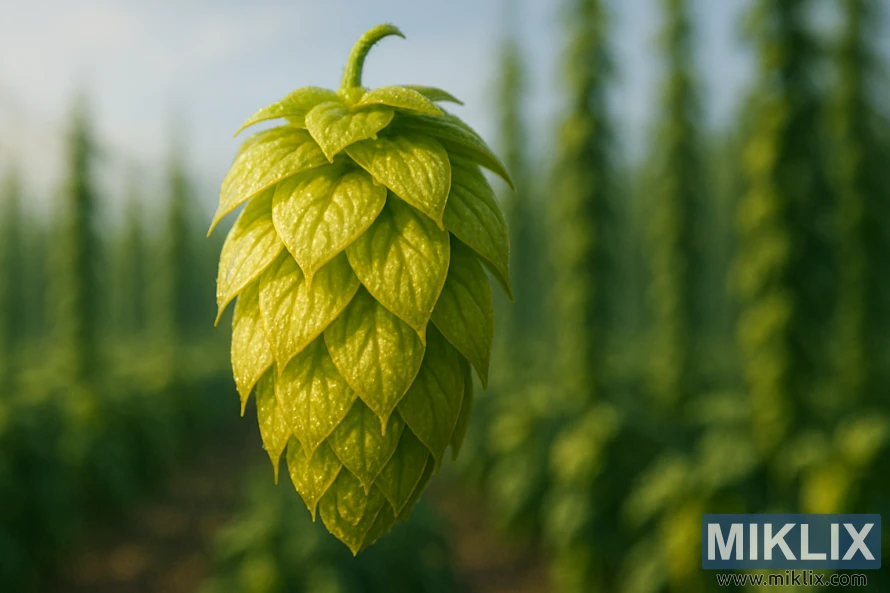
California Cluster Hops in Different Beer Styles
California Cluster Hops offer brewers the flexibility to experiment with a range of beer styles. Their unique characteristics make them suitable for brewing various beers, from crisp American Pale Ales to robust Porters.
One of the primary advantages of using California Cluster Hops is their versatility. They can be used in a variety of beer styles, including:
- American Pale Ale: Known for its balanced flavor and aroma, California Cluster Hops add a subtle hoppy character to this style.
- Porter: The robust flavor of Porter is complemented by the earthy and woody notes of California Cluster Hops.
- IPA: For India Pale Ale, these hops contribute to a complex aroma profile with notes of citrus and pine.
The chemical composition of California Cluster Hops, including their alpha acid content and essential oils, makes them an excellent choice for brewers looking to create a range of beer styles. Their brewing properties allow for a variety of hop products, from whole cones to pellets.
When brewing with California Cluster Hops, it's essential to consider the specific characteristics of the hop variety and how they will interact with other ingredients in the beer. This includes understanding the hop's alpha acid content, beta acid content, and the profile of essential oils.
By carefully selecting and utilizing California Cluster Hops, brewers can create a diverse portfolio of beers that cater to different tastes and preferences. Whether it's a refreshing American Pale Ale or a rich, malty Porter, these hops provide a foundation for crafting high-quality beers.
Comparing California Cluster Hops with Other Varieties
To truly appreciate California Cluster Hops, comparing them with other hop varieties is key. This comparison sheds light on their unique characteristics and brewing applications. It helps brewers understand how Cluster Hops stand out from the rest.
Cluster Hops from California are often seen as identical to other Cluster varieties in brewing. Yet, when matched against popular hops like Cascade, Chinook, or Centennial, they reveal distinct flavor and aroma profiles.
Cluster Hops are known for their earthy and herbal flavors. In contrast, Cascade hops offer citrus and floral notes. Cluster Hops also provide a smooth, rounded bitterness, unlike the sharper bitterness found in some other varieties.
Cluster Hops have a subtle, spicy aroma. This is different from Chinook hops, which have a more pronounced pine and spice aroma.
- Cluster Hops: Earthy, herbal flavor profile; smooth bitterness; subtle, spicy aroma.
- Cascade Hops: Citrus, floral flavor profile; moderate bitterness; floral, citrus aroma.
- Chinook Hops: Pine, spice flavor profile; high bitterness; pine, spice aroma.
For brewers, understanding these differences is vital. It allows them to choose the right hop variety for their beer styles. By comparing Cluster Hops with others, brewers can make better decisions about their hops.
Best Practices for Brewing with California Cluster Hops
The art of brewing with California Cluster Hops requires attention to detail. This includes hop addition rates and fermentation techniques. To maximize these hops' benefits, brewers must consider several key factors. These factors influence the final product's quality and character.
One critical aspect is hop addition rates. California Cluster Hops offer a balanced alpha acid content. This makes them suitable for various beer styles. They can be used for bittering, flavor, and aroma additions. For bittering, a higher alpha acid content is used, typically in the early boil stages. For flavor and aroma, later additions or dry-hopping are better to preserve the hop's delicate characteristics.
Brewing temperatures are also vital in extracting the best from California Cluster Hops. Optimal temperatures during fermentation are essential for preserving the hop's flavor and aroma compounds. The choice of yeast strain and temperature control during fermentation can greatly affect the beer's profile. Generally, cooler temperatures help preserve more of the hop's delicate flavors.
To fully exploit California Cluster Hops, brewers should follow these best practices:
- Monitor and adjust hop addition rates based on the desired bitterness and flavor profile.
- Optimize brewing temperatures to preserve the hop's characteristics.
- Select appropriate yeast strains that complement the hop's flavor and aroma.
- Control fermentation temperatures to achieve the desired outcome.
By following these guidelines, brewers can achieve a balanced bitterness and flavor profile. This leverages the unique qualities of California Cluster Hops. It results in high-quality beers that meet consumer expectations.
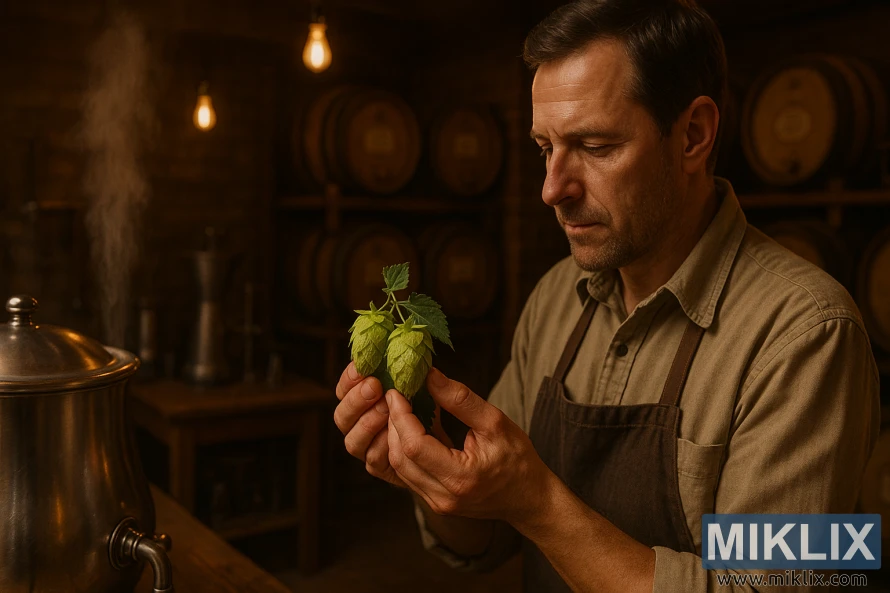
Common Challenges and Solutions
California Cluster Hops offer unique traits but come with brewing challenges. Brewers often face issues with bitterness, flavor, and aroma when using these hops.
Managing bitterness is a primary challenge. These hops have high alpha acid content, leading to overly bitter beers if not managed. Brewers can adjust hopping rates or timing to achieve the right bitterness level.
Flavor and aroma are also critical areas where brewers may encounter challenges. The unique flavor profile of California Cluster Hops can be an asset. But, it requires precise brewing techniques to be fully appreciated. Solutions include optimizing the dry-hopping process and ensuring that brewing equipment is well-maintained to prevent contamination or off-flavors.
- Monitor and adjust hopping rates to balance bitterness.
- Optimize dry-hopping techniques to enhance flavor and aroma.
- Maintain brewing equipment to prevent contamination.
By understanding these challenges and implementing the right solutions, brewers can effectively use California Cluster Hops. This results in high-quality beers with unique characteristics.
Commercial Applications and Market Trends
Market trends show a consistent demand for California Cluster Hops in brewing. Their versatility allows them to be used in a variety of beer styles, from pale ales to porters.
In the US, brewers widely use California Cluster Hops for their pleasant bitterness and flavor. Craft breweries, in particular, appreciate these hops for their unique qualities. These qualities enable the creation of distinctive beers that differentiate themselves in a competitive market.
California Cluster Hops' applications extend beyond traditional brewing. They are also used in specialty hops products, like hop extracts and pellets. These products are becoming more popular among brewers for their convenience and consistency.
- Increased demand for craft brewing ingredients
- Growing popularity of specialty hops products
- Expanding market for hop extracts and pellets
The brewing industry's evolution will likely keep the demand for California Cluster Hops positive. This is due to their versatility and the ongoing innovation in brewing techniques and products.
Sustainability and Environmental Impact
The growing need for sustainable brewing highlights the importance of understanding California Cluster Hops' environmental footprint. Their cultivation affects water usage, pesticide needs, and waste management significantly. These factors are critical for the environment.
California Cluster Hops are prized for their adaptability, thriving in various climates and soils. This versatility makes them a valuable crop for many farmers. Yet, their growth demands careful management to lessen environmental harm.
Water usage is a major environmental concern in hop cultivation. Hops need substantial water, mainly during the hot summer months. To combat this, farmers are adopting more efficient irrigation systems. These efforts aim to reduce water waste and preserve this essential resource.
Pesticide use is another critical issue in hop farming. While pesticides are necessary to protect the crop, their use can harm the environment. This includes contaminating waterways and affecting beneficial insects. To address this, integrated pest management (IPM) practices are being implemented. These aim to reduce pesticide use and mitigate environmental risks.
Effective waste management is also essential. Hop farming generates waste like spent hops, packaging, and pruning debris. Implementing waste reduction and recycling programs can greatly reduce the environmental impact of hop cultivation.
To boost sustainability, hop farmers and brewers can follow several best practices:
- Implementing efficient irrigation systems to reduce water usage.
- Adopting IPM practices to minimize pesticide use.
- Implementing waste reduction and recycling programs.
- Promoting biodiversity through the use of cover crops and conservation tillage.
By embracing these practices, the hop industry can significantly lessen its environmental impact. This contributes to a more sustainable future for brewing.
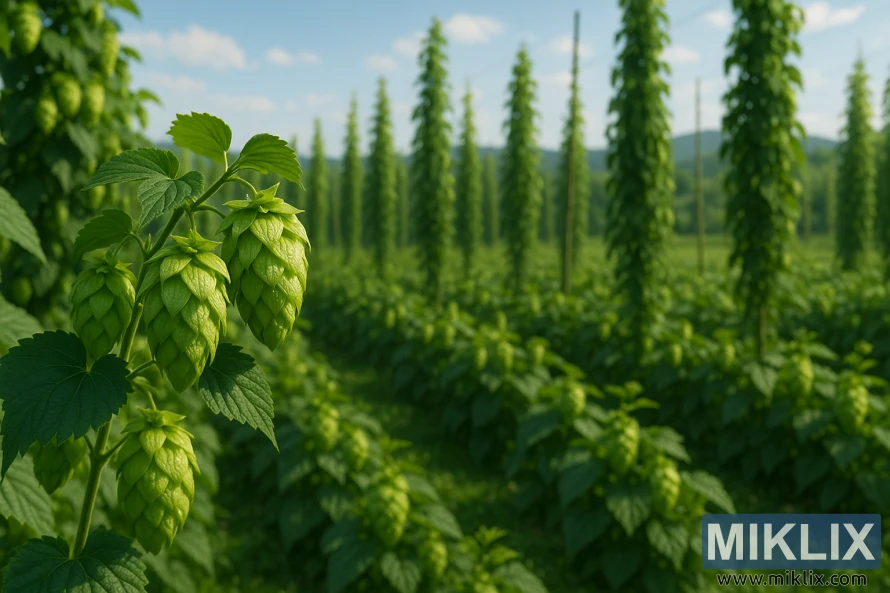
Quality Assessment and Selection Tips
To brew the best beer, understanding how to evaluate California Cluster Hops is essential. The quality of these hops can significantly impact the flavor and aroma of your beer. Here, we will discuss the key factors to consider when assessing the quality of California Cluster Hops.
When evaluating California Cluster Hops, several factors are important. These include appearance, aroma, and flavor. Each characteristic offers valuable insights into the overall quality of the hops.
- Appearance: High-quality California Cluster Hops should have a vibrant green color and a fresh appearance. Avoid hops that appear dry, discolored, or have visible signs of mold.
- Aroma: The aroma of California Cluster Hops is a critical indicator of their quality. Fresh hops should have a pleasant, earthy, and slightly spicy aroma. Any sour or unpleasant odors can indicate poor quality.
- Flavor: The flavor profile of California Cluster Hops is another essential factor. They should contribute a balanced bitterness and a subtle earthy flavor to your beer.
- Purchase hops from reputable suppliers to ensure they are fresh and of high quality.
- Check the hops' packaging date and storage conditions to ensure they have been properly preserved.
- Evaluate the hops' appearance, aroma, and flavor before using them in your brewing process.
By following these guidelines, brewers can ensure they are using high-quality California Cluster Hops. This results in a better-tasting beer. The quality assessment and selection process is critical in achieving the desired flavor and aroma profiles in your brews.
Future Prospects of California Cluster Hops
California Cluster Hops are set to grow and innovate in the brewing world. Their rich history and unique traits make them a favorite for brewers. They're eager to try new flavors and styles.
The future looks bright for California Cluster Hops. They're expected to play a big role in many beer styles. Brewers can use these hops to create beers that meet changing consumer tastes.
- Try different brewing methods to highlight unique flavors.
- Mix California Cluster Hops with other hops for complex tastes.
- Give traditional beers a new twist with California Cluster Hops.
Consumer demand for unique, high-quality beers will drive California Cluster Hops' growth. As brewers keep experimenting, this hop's popularity will soar.
Conclusion
California Cluster Hops stand out as a versatile and valuable hop variety. They are suitable for brewing a wide range of beer styles. This guide has highlighted their unique characteristics, making them an attractive choice for brewers.
The history, growing conditions, and brewing properties of these hops have been thoroughly discussed. This showcases their versatility across different beer styles. The analysis of their aroma and flavor profile reveals their ability to enhance beer complexity and depth.
In summary, California Cluster Hops are a valuable addition to any brewer's collection. They offer a multitude of possibilities for brewing various beer styles. By grasping the key points from this guide, brewers can make informed decisions about incorporating these hops into their brewing process.
Further Reading
If you enjoyed this post, you may also like these suggestions:
- Hops in Beer Brewing: Yakima Gold
- Hops in Beer Brewing: Huell Melon
- Hops in Beer Brewing: Yakima Cluster
